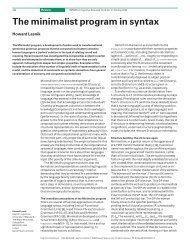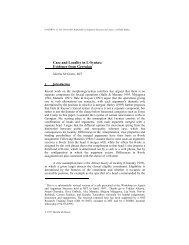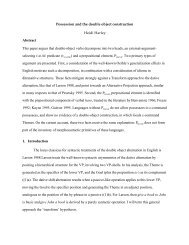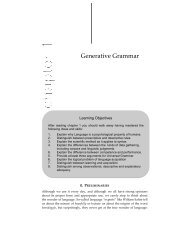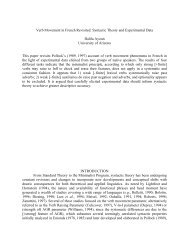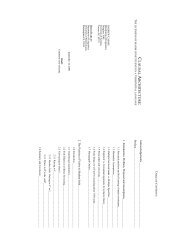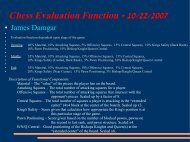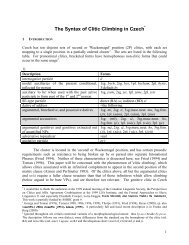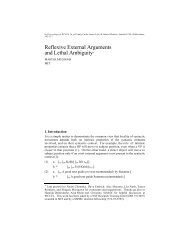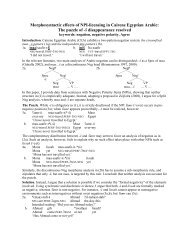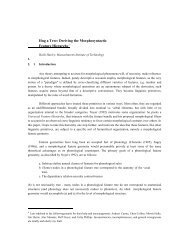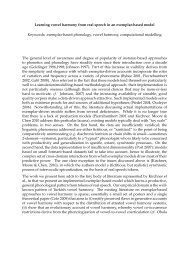Inflectional Verb Forms in Maltese
Inflectional Verb Forms in Maltese
Inflectional Verb Forms in Maltese
You also want an ePaper? Increase the reach of your titles
YUMPU automatically turns print PDFs into web optimized ePapers that Google loves.
Stem allomorphy <strong>in</strong> <strong>Maltese</strong> verbs<br />
The <strong>in</strong>flectional verb<br />
forms of <strong>Maltese</strong><br />
1
Ray Fabri<br />
Institute of L<strong>in</strong>guistics<br />
University of Malta
Ray Fabri<br />
L-Istitut tal-L<strong>in</strong>gwistika<br />
L-Università ta’ Malta
Senior lecturer <strong>in</strong>:<br />
General L<strong>in</strong>guistics<br />
Areas of specialisation:<br />
morpho-syntax, theories of grammar,<br />
typology, <strong>Maltese</strong> grammar<br />
Co-ord<strong>in</strong>ator of programme for<br />
English for Academic Purposes<br />
4
•Member of the<br />
National Council for the <strong>Maltese</strong> Language<br />
Il-Kunsill Nazzjonali ta’ l-Ilsien Malti<br />
•Head of<br />
Committee on <strong>Maltese</strong> and ICT<br />
with<strong>in</strong> the Council<br />
•Member of board of the<br />
International Association for <strong>Maltese</strong> L<strong>in</strong>guistics<br />
L-Għaqda Internazzjonali tal-L<strong>in</strong>gwistika Maltija<br />
(Għilm) founded <strong>in</strong> Bremen <strong>in</strong> November 2007<br />
• Chairman of a<br />
Committee on <strong>Maltese</strong> <strong>in</strong> the Broadcast<strong>in</strong>g Media<br />
5
1.The language situation <strong>in</strong> Malta<br />
2.<strong>Maltese</strong><br />
3.The verb system<br />
4.Stem allomorphy: the facts<br />
5. Stem allomorphy: account<strong>in</strong>g<br />
for the facts (some speculative<br />
ideas)
The language<br />
situation <strong>in</strong> Malta<br />
7
The language situation <strong>in</strong> Malta<br />
Italian<br />
English borrow<strong>in</strong>g <strong>Maltese</strong><br />
BE/AE (ma<strong>in</strong>ly lexical) Standard and<br />
dialects<br />
<strong>Maltese</strong><br />
English<br />
ME mixed<br />
with <strong>Maltese</strong><br />
<strong>Maltese</strong> mixed with ME<br />
Close to<br />
BE/AE<br />
Further from<br />
BE/AE<br />
L1 L2 EFL<br />
8
The Constitution<br />
Section 5 [National Language], chapter I:<br />
the "national language of Malta is the<br />
<strong>Maltese</strong> language”<br />
with "the <strong>Maltese</strong> and the English<br />
languages" as "the official languages of<br />
Malta"<br />
9
Official languages:<br />
"the Adm<strong>in</strong>istration may for all official<br />
purposes use any of such languages… The<br />
language of the courts shall be the <strong>Maltese</strong><br />
language" and "the House of Representatives<br />
may, <strong>in</strong> regulat<strong>in</strong>g its own procedure,<br />
determ<strong>in</strong>e the language or languages that<br />
shall be used <strong>in</strong> Parliamentary proceed<strong>in</strong>gs<br />
and records."<br />
10
L-ILSIEN MALTI<br />
df-tongue <strong>Maltese</strong><br />
THE MALTESE<br />
LANGUAGE<br />
11
Aħbarijiet | 24 ta’ Awwissu 2008<br />
•<br />
Nr 95<br />
Il-vjaġġ politiku tal-ewroxettika<br />
Sharon Ellul Bonici<br />
M<strong>in</strong>n le għal ‘iva’<br />
Julia Farrugia<br />
Kienet parti mill-kampanja ‘Le<br />
għall-UE’ fl-2003 u ikkontestat l-<br />
elezzjoni ta’ dik is-sena mal-<br />
MLP.<br />
Sena wara ttantat tkun kandidata<br />
għall-MLP fl-elezzjoni tal-<br />
Parlament Ewropew imma<br />
twaqqfet mill-Bord tal-Viġilanza.<br />
(Aqra Iktar)<br />
Intervista<br />
Il-pastażati<br />
fid-demm<br />
Franica<br />
Pulis<br />
t<strong>in</strong>tervista lil<br />
Gianni<br />
Zammit<br />
Download the<br />
front page of<br />
ILLUM <strong>in</strong> PDF<br />
format<br />
Email:<br />
illum@mediato<br />
day.com.mt
Clip from national television progamme<br />
about the <strong>Maltese</strong> language with well<br />
known local personalities.<br />
1. Peppi Azzopardi: popular TV presenter<br />
2. Manwel Mifsud: chairman of the National<br />
Council for the <strong>Maltese</strong> Language<br />
3. Olv<strong>in</strong> Vella: executive secretary of the<br />
Council<br />
4. Trevor Zahra: a well known <strong>Maltese</strong> author<br />
5. Lou Bondi: the presenter
2. Extract from the newspaper It‐Torċa (30/4/2006)<br />
Noel Turner kien il‐mutur tal‐Blues f'nofs il‐grawnd fejn<br />
wettaq ħafna xogħol utli, imma Valletta dehru jikkontrollaw<br />
tajjeb, m<strong>in</strong>kejja li bdew m<strong>in</strong>għajr Sullivan u Fenech, li lanqas<br />
biss kienu fost is‐sostituti… l‐ewwel taqsima … ntemmet<br />
m<strong>in</strong>għajr gowls.<br />
(http://www.it‐torca.com/)<br />
Noel Turner was the Blues’ motor <strong>in</strong> midfield, where he did<br />
some very useful work; but Valletta seeemed to control the<br />
game well, although they started without Sullivan and Fenech,<br />
who were not even present among the substitute players...<br />
The first half ended without any goals.<br />
14
3. Vocabulary<br />
utli : useful Italian : utile/i<br />
jikkontrollaw : they contol Italian : controllare<br />
sostitut : substitute Italian : sostituto/i<br />
Blues : the Blues English : Blues<br />
grawnd : ground/pitch English : ground<br />
gowls : goals English : goal/s<br />
nofs : middle Arabic : nusf (half)<br />
xogħol : work Arabic : xuğl (work)<br />
m<strong>in</strong>għajr : without Arabic : m<strong>in</strong> (from) +<br />
ğajr (exception)<br />
15
INFLECTIONAL<br />
FORMS<br />
MALTESE<br />
VERBS
An overview:<br />
some basic facts
1. No <strong>in</strong>f<strong>in</strong>itive form<br />
Every verb marked for person, number, gender (though<br />
not tense and aspect)<br />
e.g. t-rid 'she wants'<br />
3fsg-want<br />
Anna t-rid t-<br />
mur<br />
t-iżfen<br />
Anna 3fsg-want 3fsg-go 3fsgdance<br />
Anna wants to go danc<strong>in</strong>g<br />
Anna ried-et t-mur<br />
t-iżfen<br />
Anna want-3fsg 3fsg-go 3fsgdance
Citation form<br />
- traditionally:<br />
3msg.perf (unmarked)<br />
e.g. kiel 'he ate'/'to eat'<br />
- colloquially:<br />
2sg.imperf (= 3fsg.imperf)<br />
e.g. t-iekol 'you eat'/'to eat'
2. The vowel melody<br />
Vowels <strong>in</strong> <strong>Maltese</strong> are not<br />
morphemes <strong>in</strong> the same sense<br />
as <strong>in</strong> Arabic.
MSA<br />
Vowel melody identifies aspect (im/perfective) and voice<br />
(passive/active)<br />
Perfective Perfective<br />
Active<br />
Passive<br />
I katab kutib<br />
II kattab kuttib<br />
III kaatab kuutib<br />
IV aktab uktib<br />
V takattab tukuttib<br />
VI takaatab tukuutib<br />
VII nkatab nkutib<br />
etc.<br />
a<br />
u-i
<strong>Maltese</strong><br />
Imperfective Perfective Perfective<br />
Active Active Passive/<br />
Medium<br />
I ikser kiser<br />
II ikisser kisser<br />
VI<br />
VII<br />
tkisser<br />
nkiser<br />
vowel melody: i – e throughout
However vowels do<br />
sometimes carry<br />
grammatical <strong>in</strong>formation
Paradigm<br />
Triliteral weak e.g. bies b w s 'kiss'<br />
u: = [-perf]<br />
= [-3, +perf]<br />
: = [+3, +perf]
Paradigm<br />
Triliteral weak<br />
sab s j b 'f<strong>in</strong>d'<br />
i: = [-perf]<br />
I = [-3, +perf]<br />
: = [+3, +perf]
Classification of<br />
verb<br />
(see also Mifsud 1994)
Stem allomorphy<br />
1. display stem variation<br />
2. do not display stem variation
Stem variation<br />
seraq 'steal'<br />
ni-sraq ni-sirq-u seraq<br />
1(sg)-steal 1-steal-pl steal(3msg)<br />
I steal we steal he stole<br />
-CCVC -CVCC- CVCVC
No stem variation<br />
iffawlja 'foul (<strong>in</strong> football)'<br />
n-iffawlja n-iffawlja-w iffawlja-jt<br />
1(sg).impf-foul 1.impf-foul-pl foul-1sg.prf<br />
I foul We foul I fouled
Semitic vs non-Semitic<br />
1. Arabic/Semitic <strong>Maltese</strong>: root based<br />
nefaq 'spend', ħaseb 'th<strong>in</strong>k', farfar 'dust', bies<br />
'kiss'<br />
2. Non-Arabic/Semitic <strong>Maltese</strong>: stem based<br />
ittajpja 'type', ixxottja 'kick', issevja 'save',<br />
spjega 'expla<strong>in</strong>', stabbilixxa 'establish'
Classificationof verbs of Arabic orig<strong>in</strong><br />
1. Triliteral<br />
seraq 'steal'<br />
CVCVC<br />
2. Quadriliteral<br />
kaxkar 'drag'<br />
CVCCVC
Triliteral<br />
1. simple<br />
niżel 'descend'<br />
<strong>in</strong>żel (imperative)<br />
C i VC j V C k<br />
2. reduplicative (trux 'deaf')<br />
xamm 'smell' xomm (imperative)<br />
C i VC j C j
Triliteral simple<br />
1. strong C =/= j/w<br />
kiteb 'write'<br />
ikteb<br />
C i<br />
C j C k<br />
2.weak at least one C = j/w<br />
wasal 'arrive' asal<br />
W C i<br />
C j
Triliteral weak<br />
1. assimilated xebbieħi<br />
wiret '<strong>in</strong>herit' iret wirt 'an <strong>in</strong>heritance;'<br />
W C i C j (<strong>in</strong>itial ‘w’, rarely ‘j’)<br />
2. hollow moħfi<br />
bies 'kiss' bus bewsa 'a kiss'<br />
C i W/J C j (medial ‘w/j’)<br />
3. lack<strong>in</strong>g nieqes<br />
kera 'rent' ikri kirja ' a rent'<br />
C i C j J/W/alif (f<strong>in</strong>al ‘j/w’)
4. silent f<strong>in</strong>al C (= għ)<br />
sema’ ‘hear’<br />
isma'<br />
semagħ-ha ‘he heard her’<br />
C i C j GĦ<br />
third radical assumed to be silent ‘għ’<br />
NB.<br />
strictly speak<strong>in</strong>g not weak but pattern with weak<br />
lack<strong>in</strong>g
Quadriliterals<br />
1.simple<br />
fixkel 'obstruct/confuse' fixkel<br />
C V C C V C<br />
2.reduplicative<br />
farfar 'dust' farfar<br />
C i VC j C i VC j<br />
Cmp. 2 nd form verbs: e.g. ħarrab 'help to escape'<br />
(see below)
'Irregular'<br />
(ma<strong>in</strong>ly through historical loss of some C)<br />
kiel ‘eat’ kul<br />
ħa ‘take’ ħu<br />
ra ‘see’ ara<br />
ġie ‘come’ ejja<br />
af ‘know’ af<br />
mar ‘go’ mur<br />
qal ‘say' għid<br />
ta ‘give’ agħti
Non-Arabic/Semitic: Romance verb, Semitic model<br />
Type 1<br />
kanta 's<strong>in</strong>g'<br />
kanta<br />
Patterns <strong>in</strong>flectionally with Semitic triliteral weak<br />
lack<strong>in</strong>g, e.g. qara ‘read’<br />
hu `qa ra ‘read’<br />
hu `kan ta ‘s<strong>in</strong>g’<br />
jien `qr-ajt ‘I read’ hi 'qra-t [raat]<br />
jien kan `t-ajt ‘I sang’ hi kan 'ta-t [kantaat]
Type 1 sub-class<br />
<strong>in</strong>itial consonant gem<strong>in</strong>ation<br />
ikkonv<strong>in</strong>ċa ‘conv<strong>in</strong>ce’ (ital. conv<strong>in</strong>cere)<br />
immoniterja ‘monitor’ (eng. ‘monitor’)<br />
ittajpja ‘type’ (eng. ‘type’)<br />
Not every loan verb has gem<strong>in</strong>ation:<br />
e.g. kanta NOT *kkanta<br />
spjega NOT *sspjega
jien n-immoniterja ‘I monitor’<br />
<strong>in</strong>t t-immoniterja ‘you monitor’<br />
hu j-immoniterja ‘he monitors’<br />
hi t-immoniterja ‘she monitors’<br />
jien immoniterja-jt ‘I monitored’<br />
<strong>in</strong>t immoniterja-jt ‘you monitored’<br />
hu immoniterja ‘he monitored’<br />
hi immoniterja-t ‘she monitored’
Non-Arabic/Semitic: Romance verb, Semitic model<br />
Type 2<br />
Patterns <strong>in</strong>flectionally with Semitic triliteral weak<br />
lack<strong>in</strong>g e.g. beda ‘beg<strong>in</strong>’<br />
hu 'fal la<br />
hu 'be ka<br />
‘he was absent’<br />
‘he cried’<br />
jien fal 'l-ejt ‘I was absent’ hi fall-iet 'she was ...'<br />
jien 'bk-ejt ‘I cried’ hi bk-iet 'she cried'
Type 2 sub-class<br />
based on Italian -isco extensional verb<br />
ital. sugger-ire ‘suggest’<br />
malt. is-suġ ġe 'r-ix xa ‘suggest’ , ‘he suggested’<br />
ital. sugger-isc-o ‘I suggest’<br />
malt. n-is suġġe 'r-ix x-i ‘I suggest’<br />
ital. sugger-iamo ‘we suggest’<br />
malt. n-is suġġe 'r-ix x-u ‘we suggest’<br />
ital. sugger- ii ‘I suggested’<br />
malt. is suġ ġe 'r-ejt<br />
ital. sugger-í ‘s/he suggested’<br />
malt. is suġ ġe 'r-ix xa ‘he suggested’
Consonant clusters<br />
Unlike Arabic, <strong>Maltese</strong> allows<br />
consonant cluster<strong>in</strong>g <strong>in</strong> loan verbs<br />
skan ta ‘be surprised/stare’<br />
kom pla ‘cont<strong>in</strong>ue’<br />
43
Non-Arabic/Semitic: Romance verb, Semitic model<br />
Type 3<br />
denom<strong>in</strong>al verb of form 2<br />
ital. serpente<br />
malt. serp<br />
verb: serrep<br />
ital. pipa<br />
malt. pipa<br />
verb: pejjep<br />
‘snake’<br />
‘snake’<br />
‘to meander’ (2nd form)<br />
‘pipe’<br />
‘pipe’<br />
‘to smoke’
<strong>Inflectional</strong> vs. derivational forms<br />
1. Derivation:<br />
il-forom (b<strong>in</strong>yanim, conjugations,<br />
themes)<br />
2. Inflection<br />
verb <strong>in</strong>flected for person, number,<br />
gender
il-forom<br />
derivational forms
triliteral<br />
quadriliteral<br />
noun/<br />
adjective<br />
daħla<br />
entrance<br />
fehma<br />
op<strong>in</strong>ion<br />
laqgħa<br />
meet<strong>in</strong>g<br />
qatla<br />
kill/murder<br />
nebħa<br />
<strong>in</strong>sight<br />
ħaġra<br />
rock<br />
abjad<br />
white<br />
tħarbita<br />
mix up<br />
1.<br />
CVCVC<br />
daħal<br />
enter<br />
fehem<br />
understand<br />
laqa’<br />
catch<br />
qatel<br />
kill<br />
nebaħ<br />
realise<br />
-- -- ħarbat<br />
2.<br />
CVCCVC<br />
3.<br />
CVVCVC<br />
daħħal<br />
let <strong>in</strong><br />
fiehem<br />
expla<strong>in</strong><br />
laqqa’<br />
get<br />
together<br />
nebbaħ<br />
<strong>in</strong>spire<br />
ħaġġar<br />
stone<br />
bajjad<br />
pa<strong>in</strong>t<br />
4.<br />
ra 'see'<br />
5.<br />
tCVCCVC<br />
6.<br />
tCVVCVC<br />
7.<br />
nCVCVC<br />
8.<br />
CtVCVC<br />
9.<br />
CCVVC<br />
10.<br />
stVCCVC<br />
tdaħħal<br />
be <strong>in</strong>serted<br />
ndaħal<br />
<strong>in</strong>terfere<br />
ftehem<br />
agree<br />
tlaqqa’<br />
be brought<br />
together<br />
tqatel<br />
wrestle<br />
nqatel<br />
be killed<br />
tnebbaħ<br />
be <strong>in</strong>spired<br />
ntebaħ<br />
realise<br />
stenbaħ<br />
wake up<br />
tbajjad<br />
bjad<br />
become<br />
white<br />
tħarbat<br />
get<br />
confused
<strong>in</strong>flectional forms
tense marker kien<br />
aspectual particles<br />
Tense and aspect forms<br />
Tense and aspect forms<br />
n-israq ‘I steal’ habitual<br />
present<br />
qed n-israq ‘I am steal<strong>in</strong>g’<br />
progressive<br />
present<br />
sa n-israq ‘I am go<strong>in</strong>g to steal’<br />
prospective<br />
kon-t qed n-israq ‘I was steal<strong>in</strong>g’ past<br />
progressive<br />
kon-t sa n-israq ‘I was go<strong>in</strong>g to steal’ past<br />
prospective<br />
‘I l ’
Two basic <strong>in</strong>flectional verb paradigms<br />
1.prefix<strong>in</strong>g (imperfective)<br />
aff-israq<br />
n-israq<br />
1sg-steal'I steal'<br />
2.suffix<strong>in</strong>g<br />
sraq-aff<br />
(perfective)<br />
sraq-t<br />
steal-1sg'I stole'
In the follow<strong>in</strong>g, I will focus<br />
on the variation <strong>in</strong> verb<br />
forms with<strong>in</strong> the two basic<br />
<strong>in</strong>flectional paradigms.
Compar<strong>in</strong>g the paradigms of:<br />
triliteral strong<br />
e.g. kiteb<br />
k-t-b 'write'<br />
and<br />
triliteral weak<br />
e.g. tar<br />
t-j-r 'fly'
Paradigm<br />
triliteral strong e.g. kiteb k-t-b 'write'
Paradigm<br />
triliteral weak hollow e.g. tar t-j-r 'fly'
Paradigm<br />
triliteral strong<br />
imperfective kiteb k t b and tar t j r
Paradigm: CV structure<br />
Triliteral strong imperfective kiteb and tar<br />
Different pattern, therefore 2 different classes
<strong>Inflectional</strong> classes<br />
kiteb = class 1 (Cl 1)<br />
tar = class 2 (Cl 2)<br />
i.e. classes determ<strong>in</strong>ed on the basis of<br />
stem form
Compar<strong>in</strong>g the paradigms of<br />
2 triliteral strong verbs:<br />
Cl 1a and Cl 1b<br />
e.g. kiteb k-t-b 'write'<br />
e.g. seraq s-r-q 'steal'
Paradigm<br />
Triliteral strong e.g. kiteb<br />
k-t-b 'write'
Paradigm<br />
Triliteral strong e.g. seraq 'steal'
Paradigm<br />
Triliteral strong imperfective kiteb and seraq
Paradigm<br />
Triliteral strong imperfective kiteb and seraq<br />
Different pattern <strong>in</strong> plural, therefore 2 different<br />
(though related) classes
<strong>Inflectional</strong> classes<br />
kiteb = class 1a (Cl 1a)<br />
seraq = class 1b (Cl 1b)
Strategy<br />
1. Identify classes <strong>in</strong> terms of stem<br />
variation<br />
2. Account for patterns with as few<br />
rules/pr<strong>in</strong>ciples/constra<strong>in</strong>ts as<br />
possible
<strong>Verb</strong> classes<br />
see handout
E.g.<br />
Account<strong>in</strong>g for stem variation 1:<br />
Cl 1a and Cl 1b<br />
Sonority and syllabification
Cl 1a: C 1 C 2 C 3 vs. Cl 1b C 1 C 2 C 3<br />
Cl 1b C 2 = l, m, n, r [+sonorant]<br />
(traditionally/orthographically also silent għ)<br />
ħaleb somot k<strong>in</strong>es seraq (lagħab)<br />
naħilbu nisomtu nik<strong>in</strong>su nisirqu (nilagħbu)<br />
Cl 1a C 2 = [-sonorant]<br />
kiteb ħataf niżel libes<br />
niktbu naħtfu n<strong>in</strong>żlu nilbsu
Informal statement:<br />
Sonorant + Obstruent cluster breaker:<br />
a vowel position is <strong>in</strong>serted before the sonorant<br />
to break up sonorant + consonant clusters<br />
E.g. nisrqu 'we steal'<br />
r cannot be <strong>in</strong> onset (*rqu) (or <strong>in</strong> coda *nisr) for<br />
reasons of sonority, therefore:<br />
nisrqu → ni sVr qu
12. Vocalism (Aquil<strong>in</strong>a 1973)<br />
Cluster breaker vowel melody:<br />
1. a - a → a naħraq naħarqu<br />
2. o - o → o noħlom noħolmu<br />
3. i - o → o nitlob nitolbu<br />
4. i - a → i niflaħ nifilħu<br />
5. i - e → i naqleb naqilbu<br />
6. e – e → i neħles neħilsu<br />
i.e. always the second vowel, with /ε/ → [] /___<br />
[+stress]<br />
NB: a = , o = , i = , e = ε
Account<strong>in</strong>g for stem variation <strong>in</strong><br />
triliteral strong verb:<br />
syllabification
Paradigm<br />
Triliteral strong e.g. kiteb<br />
k-t-b 'write'
Stem form depends on suffix:<br />
1. vocalic suffix: kitb-et, kitb-u<br />
kitb CVCC<br />
2. consonantal suffix: ktib-t, ktib-na, ktib-tu<br />
ktib CCVC<br />
3. no suffix: kiteb<br />
kiteb CVCVC<br />
→Suggests that stem variation <strong>in</strong> such cases is a<br />
result of syllabification
Assumption<br />
triliteral strong and quadriliteral verbs:<br />
vowels have lost their morpheme status,<br />
they have taken on a purely<br />
phonological/prosodic function:<br />
i.e. provid<strong>in</strong>g material for syllabify<strong>in</strong>g radicals
Theoretical assumptions 1<br />
Lexical entry of triliteral strong and quadriliteral<br />
verbs factorised <strong>in</strong>to root and vowel melody (µ<br />
= morpheme)<br />
(a) kiser<br />
[k s r] µ [i e] [+V, -N] ‘break’<br />
(b) ħarbex<br />
[s r p] µ [e] [+V, -N] ‘mess up'
Theoretical assumptions 2<br />
Lexical entry of other verbs (weak, non-Semitic)<br />
non-factorised:<br />
ipparkja ‘park’
Syllable formation 1<br />
The Syllable Builder<br />
1. operates from right to left<br />
2. checks for acceptable (optimal)<br />
syllables/words<br />
3. <strong>in</strong>serts vowel position <strong>in</strong> first available<br />
position to create acceptable (optimal)<br />
syllable<br />
4. doma<strong>in</strong> of application: radicals
Syllable formation 2<br />
The Cluster Breaker<br />
breaks up clusters of<br />
Sonorant + Obstruent by <strong>in</strong>sert<strong>in</strong>g a vowel<br />
position before the S
Syllable/word templates and filters<br />
i) optimal syllables ii) non-syllables iii) nonwords<br />
[CVC] σ *[CVVCC] σ *[CVC] w<br />
[CCVC] σ<br />
*[CCVC] w<br />
[CCVCC] σ<br />
*[VCC] w<br />
= [(C)CVC(C)] σ<br />
Stress:<br />
penultimate unless f<strong>in</strong>al is 'heavy' (VVC, VCC, ...)
Derivation of perfective of form 1 verbs<br />
Entries:<br />
1. [k,s,r] [i,e] kiser (triliteral strong)<br />
2. [r,k,b] [i,e] rikeb (triliteral strong)<br />
3. [t,f,V] [e,a] tefa (triliteral weak)<br />
4a. [t] [+1, -PL] (consonantal base)<br />
4b. [ejt] [+1, -PL] (vocalic base)
k b<br />
| | |<br />
C C C<br />
t f<br />
| |<br />
C C V<br />
e j t<br />
| |<br />
C C<br />
(float<strong>in</strong>g vowel)
PERFECTIVE 1SG: -t<br />
ksirt 'I broke'<br />
[k,s,r], [i,e]<br />
1. Affix: ksrt<br />
2. Syllable: ksVrt<br />
3. Stress: `ksVrt<br />
4.Vocalism: `ksirt (e → i/ ___ )<br />
[+stress]
PERFECTIVE 3MSG: ∅<br />
kiser 'he broke'<br />
[k,s,r], [i,e]<br />
1.Affix: ksr<br />
2. Syllable1: ksVr<br />
3. Syllable2: kVsVr<br />
3. Stress: `kV sVr<br />
4. Vocalism: `kiser
Set of radical and stem patterns<br />
(N.B. the list is not exhaustive)<br />
C C C P1 (form 1)<br />
CC i C i C P2 (form 2)<br />
C C V P3 (triliteral weak)<br />
CC a P4<br />
CVVC P5<br />
CVC i C i P6<br />
CVVCC P7<br />
CtC C P8<br />
st C C C P9<br />
tCC i C i C P10
Entries:<br />
a. [k s r] [i e]; +V, -N, P1, P2, P10<br />
(kiser ‘break’, kisser ‘break <strong>in</strong>tensively’, tkisser<br />
‘is broken’)<br />
b. [t f V] [e a]; +V, -N, P3<br />
(tefa ‘ext<strong>in</strong>guish’ )<br />
c. [f r k] [a]; +V, -N, P2, P10<br />
(farrak ‘shatter’, tfarrak ‘was shattered’ )<br />
d. [ipparjka]; +V, -N<br />
(ipparkja ‘park’)
Conclusion<br />
1. Still at level of <strong>in</strong>tuition<br />
2. Details, especially vocalism, not yet worked<br />
out<br />
3. Needs to be formalised <strong>in</strong> some current model,<br />
e.g. optimality theory<br />
4. Needs to <strong>in</strong>clude more complex verb forms<br />
with object clitics and the negative<br />
suffix/circumfix
Some examples of complex word forms<br />
n-israq<br />
n-isirq-ek<br />
n-israq-lek<br />
n-isirq-u-lek<br />
n-israq-hie-lek<br />
'I steal'<br />
'I cheat/burgle you'<br />
'I steal from you'<br />
'I steal it(3msg) from you'<br />
'I still it(3fsg) from you'<br />
ma n-israq-hi-lek-x 'I do not steal it(3fsg) from<br />
you'
Grazzi ħafna<br />
Thank you very much<br />
87



